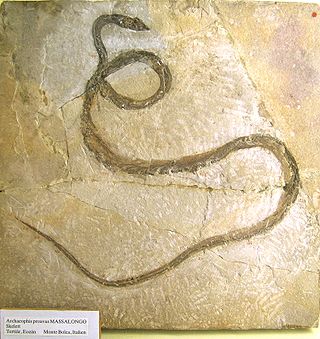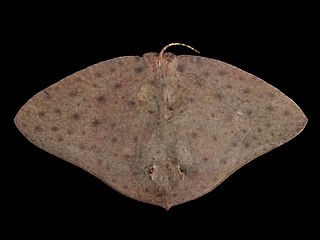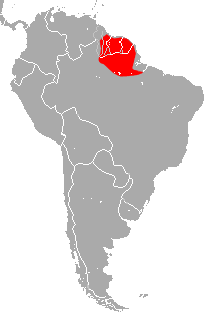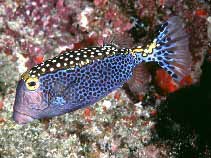
Monte Bolca is a lagerstätte near Verona, Italy that was one of the first fossil sites with high quality preservation known to Europeans, and is still an important source of fossils from the Eocene.

The butterfly rays are the rays forming the genus Gymnura and the family Gymnuridae. They are found in warm oceans worldwide, and occasionally in estuaries.

The longhorn cowfish, also called the horned boxfish, is a species of boxfish from the family Ostraciidae, recognizable by its long horns that protrude from the front of its head, rather like those of a cow or bull. They are a resident of the Indo-Pacific region and can grow up to 50 cm (20 in) long.

The Mercedes-Benz Bionic is a concept car created by DaimlerChrysler AG under the Mercedes Group. It was first introduced in 2005 at the DaimlerChrysler Innovation Symposium in Washington, D. C. The Bionic is modeled after a type of fish, the yellow boxfish, Ostracion cubicus, and also has 80% lower nitrogen oxide emissions with its selective catalytic reduction technology.

The Amazonian sac-winged bat is a bat species of the family Emballonuridae native to South America.

Ostracion is a genus of the boxfish family Ostraciidae. Fish in the genus are known as box puffers. It was first described by Carl Linnaeus in 1758 and makes a brief appearance in Jules Verne's maritime sci-fi novel Twenty Thousand Leagues Under The Sea.

The yellow boxfish is a species of boxfish found in reefs throughout the Pacific Ocean and Indian Ocean as well as the southeastern Atlantic Ocean. Recorded occasionally since 2011 in the Levantine waters of the Mediterranean Sea which it likely entered via the Suez Canal, it is a species appreciated in the aquarium trade.

The moonrat is a southeast Asian species of mammal in the family Erinaceidae. It is the only species in the genus Echinosorex. The moonrat is a fairly small, primarily carnivorous animal which, despite its name, is not closely related to rats or other rodents. The scientific name is sometimes given as Echinosorex gymnurus, but this is incorrect.

The smooth butterfly ray is a species of cartilaginous fish in the family Gymnuridae. It is a member of the order Myliobatiformes, which contains 10 total families. Its natural habitats are shallow seas, subtidal aquatic beds, estuarine waters, and coastal saline lagoons. Its common name is derived from its compressed body, pectoral fins that are wider than their length, and overall diamond shape.

The longtail butterfly ray is a species of butterfly ray, family Gymnuridae, native to the Indo-Pacific from the Red Sea to southern Japan and western Indonesia. Growing up to 92 cm (36 in) across, this ray has a lozenge-shaped pectoral fin disc about twice as wide as long, colored brown to gray above with many small, light spots. The spiracles behind its eyes have smooth rims. This species can be identified by its tail, which is about as long as the snout-to-vent distance, lacks fins, and bears nine to twelve each of alternating black and white bands.

Tetrosomus gibbosus, commonly called camel cowfish because of the hump on its dorsal keel, is one of 22 species in the boxfish family, Ostraciidae. It is a ray finned fish. Other common names include helmet cowfish, humpback turretfish and thornbacked boxfish. It is most closely related to T. reipublicae, the smallspine turretfish. T. gibbosus is a species of boxfish found in the wide Indo-West Pacific. It has been recorded since 1988 on rare occasions in the Levantine waters of the Mediterranean Sea, likely following entry via the Suez Canal. It is the first species from the family Ostraciidae to be found in the Mediterranean Sea.

The spiny butterfly ray or giant butterfly ray is a species of butterfly ray, family Gymnuridae, native to the shallow coastal waters of the Atlantic Ocean. A large ray that can measure over 2 m across, it may be distinguished from the sympatric smooth butterfly ray by the spine at the base of its tail and by a small tentacular structure on the margin of each spiracle. Slow-reproducing and valued for its meat, in recent decades its population has experienced a decline of over 30%, and it has become Critically Endangered in certain parts of its range.

The spotted or white-spottedboxfish, is a species of boxfish found in the Indian and Pacific Oceans. It is found on reefs at depths of from 1 to 30 metres. This species grows to a length of 25 centimetres. Males and females differ in colour: males are blackish on the back with white spots, and have bluish sides with bright yellowish bands and spots. Females and juveniles are dark brown to blackish with white spots. As with other species of boxfish, the spotted boxfish's bony carapace gives it a distinctly angular appearance; it has been described as resembling an ottoman.

Capropygia unistriata, also known as the Black-banded pygmy boxfish, is a species of deepwater boxfish found in the waters over the continental shelf off the southern coast of Australia. It can be found at depths of from 60 to 200 metres. This species grows to a length of 12 centimetres (4.7 in) TL. This species is the only known member of the genus Capropygia.
Polyplacapros tyleri, also known as the tyler's boxfish, is a species of deepwater boxfish native to the southwestern Pacific Ocean where it is found near Australia, New Zealand and the sea mounts of the Norfolk Ridge at a depth of around 132 metres (433 ft). This species is the only known member of the genus Polyplacapros.
Paracanthostracion lindsayi is a species of boxfish endemic to New Zealand. This species is the only known member of the genus Paracanthostracion.

Aracana ornata, also known as the ornate cowfish, is a species of deepwater boxfish native to southern Australia. First described by John Edward Gray in 1838, the species has a maximum length of 15 cm. They can be differentiated from their close cousins, the striped cowfish, by the upright look of the spines near their eyes, and their slightly smaller length. Their body is encased in a rigid box-like carapace composed of large sculptured bony plates; bony ridges with large recurved spines, dorsal and anal fins opposite and far back on the body, and bony plates on tail base absent/rudimentary.

Aracana aurita, striped cowfish, Shaw's cowfish, striped boxfish, painted boxfish, southern cowfish or Shaw's boxfish is a species of boxfish native to the Eastern Indian Ocean. The species was first described by George Shaw in 1798. It is carnivorous and exposes prey in the benthic zone by blowing a jet of water onto sediment.

Ostracion nasus also known as the Shortnose boxfish is a species of boxfish found in the Indian and Pacific Oceans. This species grows to a length of 30 centimetres (12 in) TL.

Gymnura japonica, the Japanese butterfly ray , is a species of ray in the family Gymnuridae. It is found from Japan to Cambodia.


















